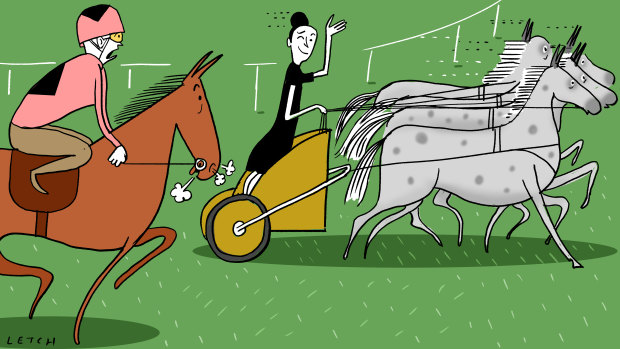Think investing is just a gamble? Only if you make it one

Save articles for later
Add articles to your saved list and come back to them any time.
“Investing in the sharemarket is like gambling.” I first heard this phrase as a teenager. Over the years, I would come to hear it many more times and by the time I reached adulthood, I had a well-ingrained fear of share market investing.
Now, after years of helping people develop more financial confidence, I know I’m not alone. The sentiment that investing in shares is like gambling is a surprisingly common one.
And the truth is, it’s not totally unfounded.
Investing can be a gamble – but how you approach it can make all the difference.Credit: Simon Letch
Understanding where this sentiment comes from helped me deal with my own fear of the sharemarket. Today, I hope it’ll do the same for you. So, let’s take a look at why people think share market investing is akin to gambling.
1. Gambling is more about your approach than it is about the asset. Whether you are gambling is less about the asset you’re buying, and more about how you’re engaging in the process of buying and selling.
Are you in it for a quick buck? Are you hoping it’ll turn out well? Did you make your decision to buy or sell based on what everyone else is doing as opposed to making an educated decision?
Investing in shares doesn’t have to be like gambling. Whether it is, is much more within your control than many people think.
If so, there’s a good chance you’re essentially taking a gamble.
Unfortunately, this approach is common. Many people do buy shares based on what they heard will do well or in the hopes of making a quick buck. When things go poorly in these cases, it’s easy to draw the conclusion that: “See, shares are risky. You never know what’s going to happen.”
What might be closer to the truth is: “Maybe that person didn’t know what they were doing. Maybe they were speculating instead of investing. Maybe it was their approach which resulted in the loss, not the asset class or market as a whole.”
See, if you hopped in a car with no map, no direction, no idea how to drive, just hoping you’ll end up somewhere good, what are your chances? Compare this to someone who knows how to drive, understands the road rules and has Google Maps.
They’re both doing the same thing (driving a car), but how they’re approaching it will make all the difference to the outcome, and the level of risk they’re exposed to.
2. Technology has dramatically changed the investing game. Firstly, imagine trying to buy shares before the internet existed.
Access to information about markets and individual stocks was far more limited and less instantaneous. Brokers were real people who you’d call to place a trade with over the phone.
This meant the everyday investor was disadvantaged because they didn’t have the cheap and immediate access to the kind of information they do today. This also left more room for less-than-honest practices. Financial intermediaries like brokers had more influence and power which could be exploited.
Secondly, you also didn’t have the same investment products as you do today. Just a few decades ago, investing in shares more or less meant buying shares in a specific company, or giving your money to a fund that would do that for you.
Today, you no longer have to invest in a specific company. See, it turns out that statistically most people aren’t great at selecting which companies are going to win or lose over the long term.
But while it’s hard to predict which companies will do well, the data shows that the sharemarket as a whole performs well over the long term. Yes, there are recessions, but the market tends to recover.
However, until relatively recently, everyday investors didn’t have an accessible way to invest in the market as whole. Then in the ’70s, John Bogle founded the first index fund.
Suddenly, instead of giving your money to a fund that was going to pick specific companies to invest in, you could give your money to a fund that would simply aim to replicate market returns.
It does this by tracking a specific index, which for example might follow the top 200 or 300 companies in a particular market. Instead of buying one company, you have instant exposure to the returns of every company in that index.
This way, it not only gives the investor immediate diversification, it reduces a lot of the risk of human error by taking out the guesswork involved in picking specific companies. These technologies allow investors to manage risks in ways you couldn’t do a few decades ago.
Now, that doesn’t mean investing in the sharemarket is risk-free. No form of investing is. But it does make it a lot less of a ‘gamble’ than it once used to be. And investing today is much more within your control than many people think.
Paridhi Jain is the founder of SkilledSmart, which helps adults learn to manage, save and invest their money through financial education courses and classes.
- Advice given in this article is general in nature and is not intended to influence readers’ decisions about investing or financial products. They should always seek their own professional advice that takes into account their own personal circumstances before making any financial decisions.
For expert tips on how to save, invest and make the most of your money, delivered to your inbox every Sunday, sign up for our Real Money newsletter here.
Most Viewed in Money
From our partners
Source: Read Full Article

